PE4S166: Epidemiology in Public Health - Disease, Smoking Analysis
VerifiedAdded on 2023/06/12
|6
|1219
|119
Homework Assignment
AI Summary
This epidemiology assignment examines the measures of disease, specifically focusing on the relationship between smoking and duodenal ulcers, as well as the impact of fluoridation on dental erosion. The analysis calculates the relative risks for past and current smokers compared to non-smokers, highlighting the health implications of continued smoking versus quitting. Furthermore, the study investigates the incidence of dental erosion in children living in fluoridated and non-fluoridated areas, revealing a higher risk of dental erosion among children exposed to fluoridated water. The conclusion emphasizes the importance of understanding these epidemiological factors for public health interventions and preventative measures. Desklib provides this document as a valuable resource for students studying epidemiology, offering insights into real-world applications of disease measurement and risk assessment.
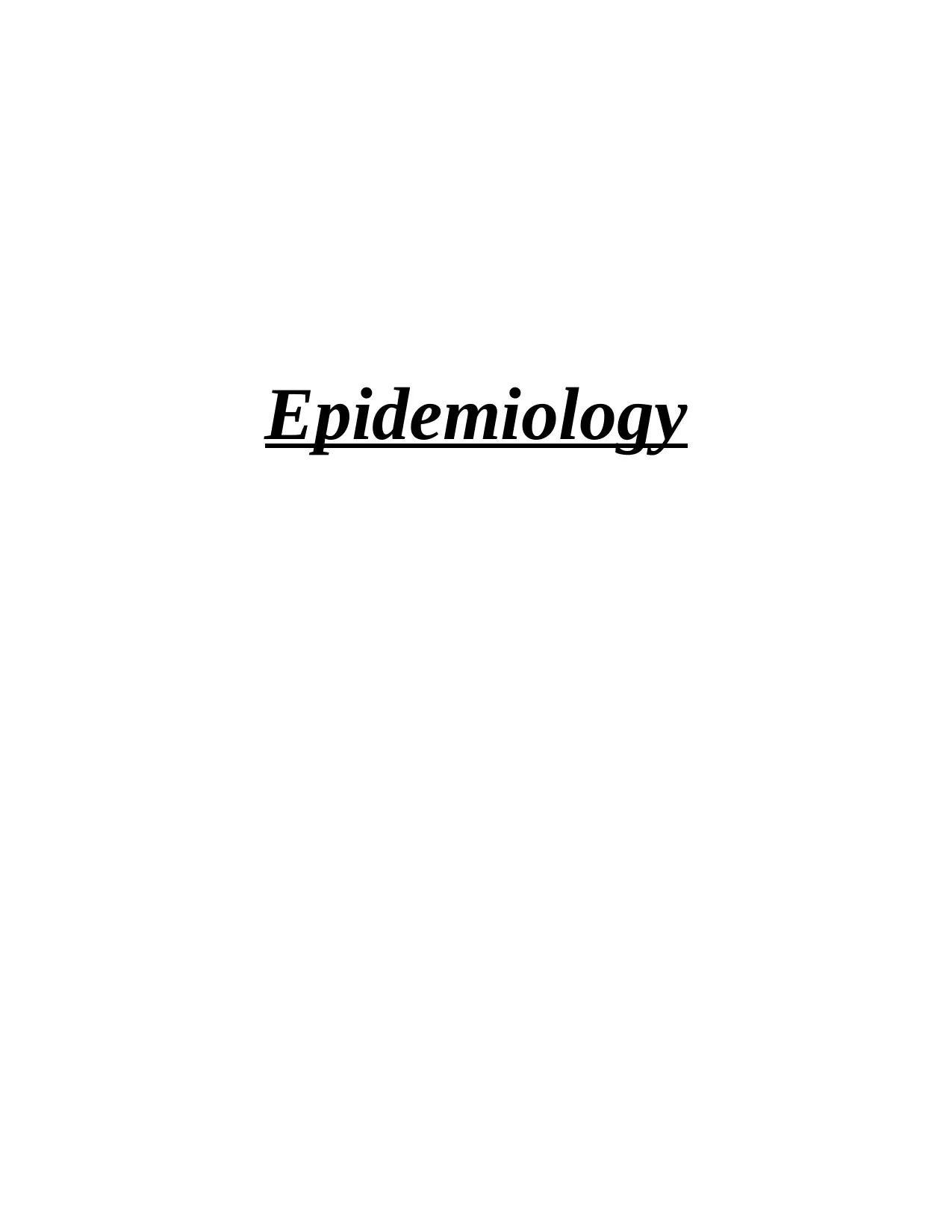
Epidemiology
Paraphrase This Document
Need a fresh take? Get an instant paraphrase of this document with our AI Paraphraser
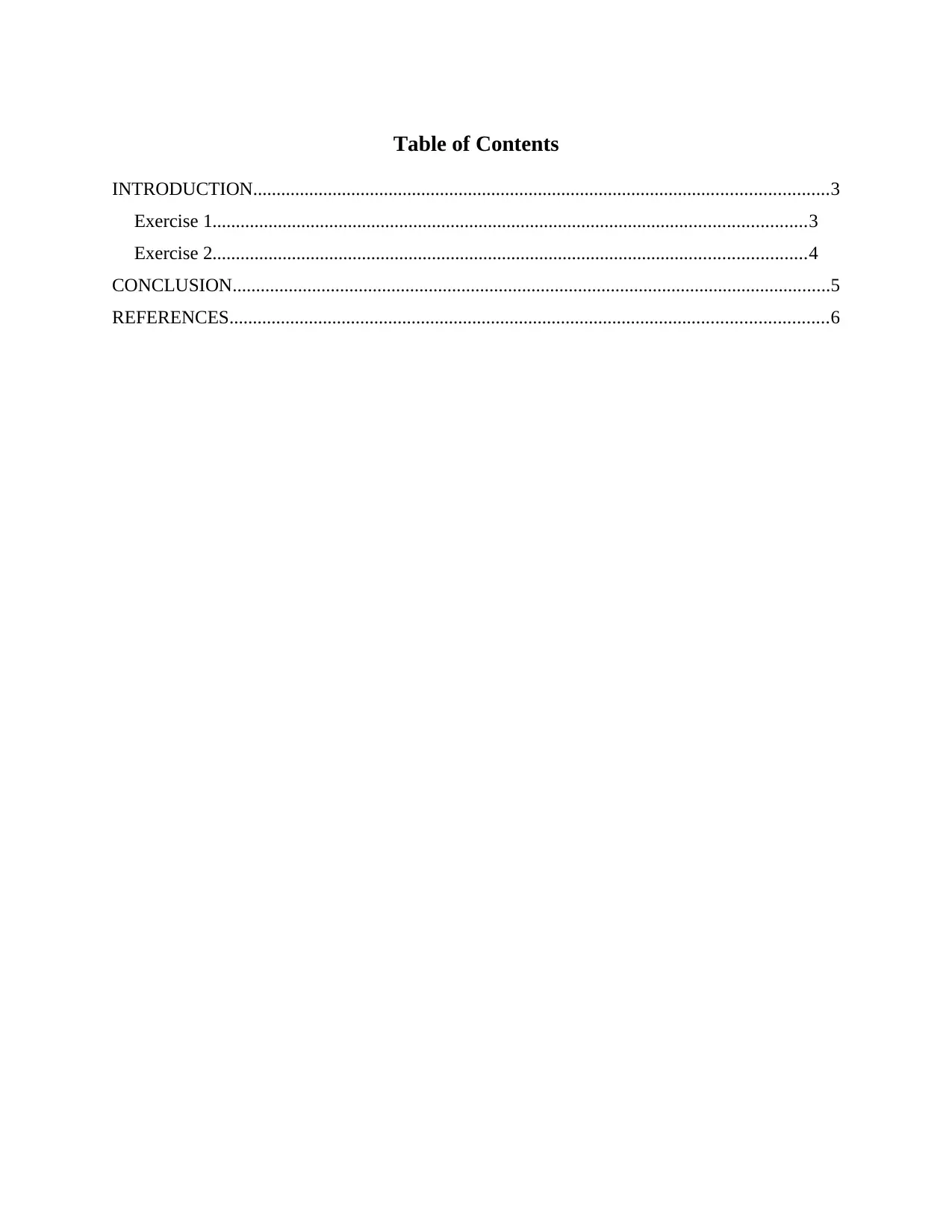
Table of Contents
INTRODUCTION...........................................................................................................................3
Exercise 1...............................................................................................................................3
Exercise 2...............................................................................................................................4
CONCLUSION................................................................................................................................5
REFERENCES................................................................................................................................6
INTRODUCTION...........................................................................................................................3
Exercise 1...............................................................................................................................3
Exercise 2...............................................................................................................................4
CONCLUSION................................................................................................................................5
REFERENCES................................................................................................................................6
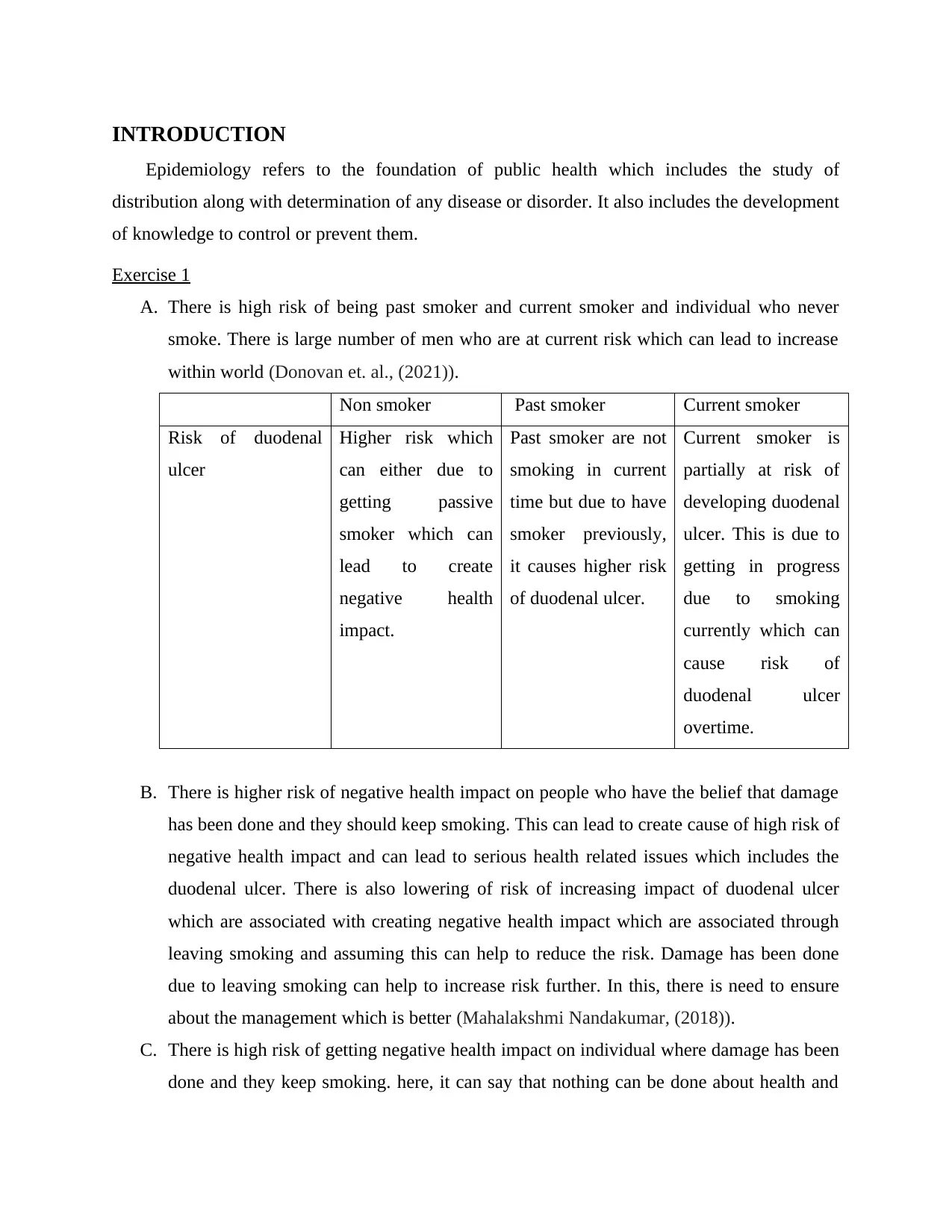
INTRODUCTION
Epidemiology refers to the foundation of public health which includes the study of
distribution along with determination of any disease or disorder. It also includes the development
of knowledge to control or prevent them.
Exercise 1
A. There is high risk of being past smoker and current smoker and individual who never
smoke. There is large number of men who are at current risk which can lead to increase
within world (Donovan et. al., (2021)).
Non smoker Past smoker Current smoker
Risk of duodenal
ulcer
Higher risk which
can either due to
getting passive
smoker which can
lead to create
negative health
impact.
Past smoker are not
smoking in current
time but due to have
smoker previously,
it causes higher risk
of duodenal ulcer.
Current smoker is
partially at risk of
developing duodenal
ulcer. This is due to
getting in progress
due to smoking
currently which can
cause risk of
duodenal ulcer
overtime.
B. There is higher risk of negative health impact on people who have the belief that damage
has been done and they should keep smoking. This can lead to create cause of high risk of
negative health impact and can lead to serious health related issues which includes the
duodenal ulcer. There is also lowering of risk of increasing impact of duodenal ulcer
which are associated with creating negative health impact which are associated through
leaving smoking and assuming this can help to reduce the risk. Damage has been done
due to leaving smoking can help to increase risk further. In this, there is need to ensure
about the management which is better (Mahalakshmi Nandakumar, (2018)).
C. There is high risk of getting negative health impact on individual where damage has been
done and they keep smoking. here, it can say that nothing can be done about health and
Epidemiology refers to the foundation of public health which includes the study of
distribution along with determination of any disease or disorder. It also includes the development
of knowledge to control or prevent them.
Exercise 1
A. There is high risk of being past smoker and current smoker and individual who never
smoke. There is large number of men who are at current risk which can lead to increase
within world (Donovan et. al., (2021)).
Non smoker Past smoker Current smoker
Risk of duodenal
ulcer
Higher risk which
can either due to
getting passive
smoker which can
lead to create
negative health
impact.
Past smoker are not
smoking in current
time but due to have
smoker previously,
it causes higher risk
of duodenal ulcer.
Current smoker is
partially at risk of
developing duodenal
ulcer. This is due to
getting in progress
due to smoking
currently which can
cause risk of
duodenal ulcer
overtime.
B. There is higher risk of negative health impact on people who have the belief that damage
has been done and they should keep smoking. This can lead to create cause of high risk of
negative health impact and can lead to serious health related issues which includes the
duodenal ulcer. There is also lowering of risk of increasing impact of duodenal ulcer
which are associated with creating negative health impact which are associated through
leaving smoking and assuming this can help to reduce the risk. Damage has been done
due to leaving smoking can help to increase risk further. In this, there is need to ensure
about the management which is better (Mahalakshmi Nandakumar, (2018)).
C. There is high risk of getting negative health impact on individual where damage has been
done and they keep smoking. here, it can say that nothing can be done about health and
⊘ This is a preview!⊘
Do you want full access?
Subscribe today to unlock all pages.

Trusted by 1+ million students worldwide
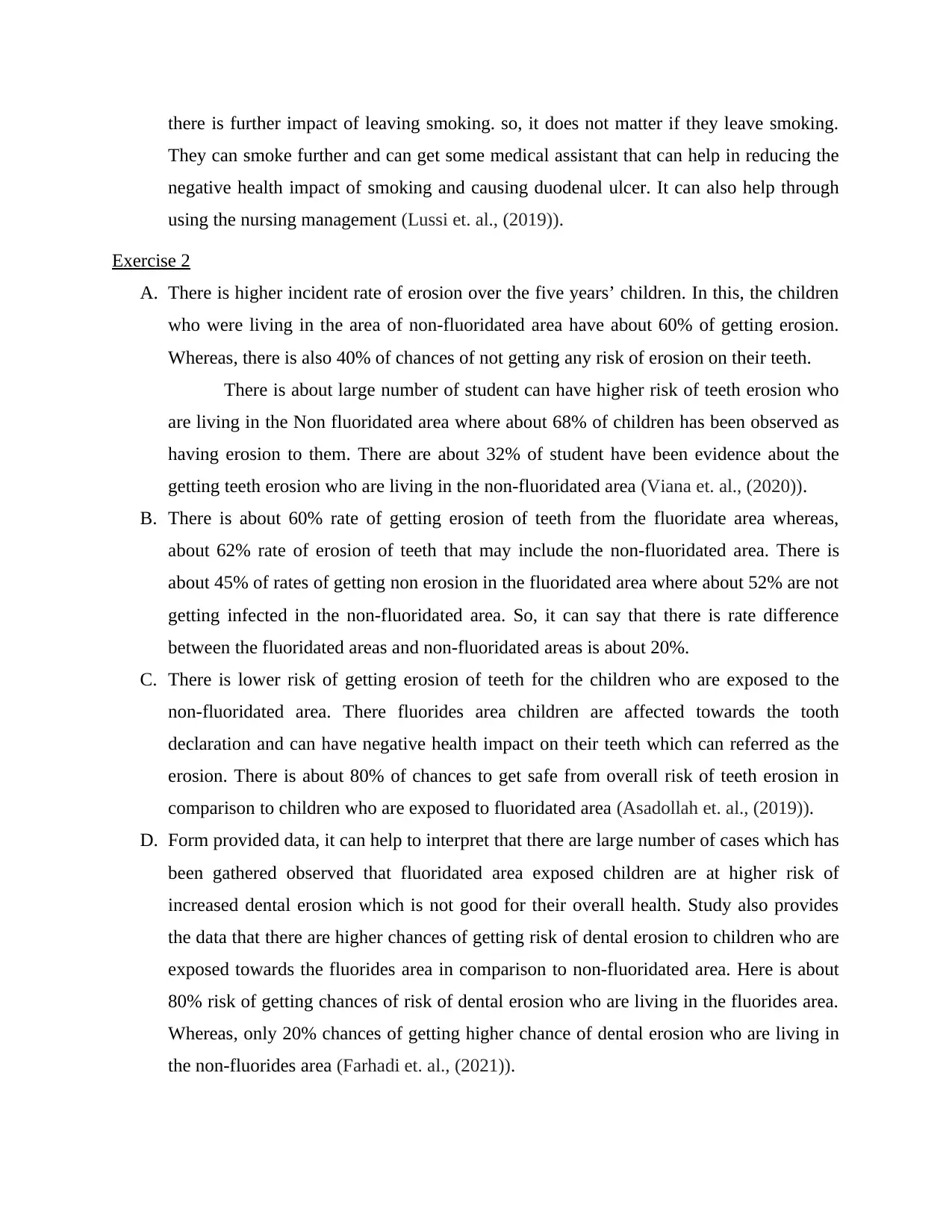
there is further impact of leaving smoking. so, it does not matter if they leave smoking.
They can smoke further and can get some medical assistant that can help in reducing the
negative health impact of smoking and causing duodenal ulcer. It can also help through
using the nursing management (Lussi et. al., (2019)).
Exercise 2
A. There is higher incident rate of erosion over the five years’ children. In this, the children
who were living in the area of non-fluoridated area have about 60% of getting erosion.
Whereas, there is also 40% of chances of not getting any risk of erosion on their teeth.
There is about large number of student can have higher risk of teeth erosion who
are living in the Non fluoridated area where about 68% of children has been observed as
having erosion to them. There are about 32% of student have been evidence about the
getting teeth erosion who are living in the non-fluoridated area (Viana et. al., (2020)).
B. There is about 60% rate of getting erosion of teeth from the fluoridate area whereas,
about 62% rate of erosion of teeth that may include the non-fluoridated area. There is
about 45% of rates of getting non erosion in the fluoridated area where about 52% are not
getting infected in the non-fluoridated area. So, it can say that there is rate difference
between the fluoridated areas and non-fluoridated areas is about 20%.
C. There is lower risk of getting erosion of teeth for the children who are exposed to the
non-fluoridated area. There fluorides area children are affected towards the tooth
declaration and can have negative health impact on their teeth which can referred as the
erosion. There is about 80% of chances to get safe from overall risk of teeth erosion in
comparison to children who are exposed to fluoridated area (Asadollah et. al., (2019)).
D. Form provided data, it can help to interpret that there are large number of cases which has
been gathered observed that fluoridated area exposed children are at higher risk of
increased dental erosion which is not good for their overall health. Study also provides
the data that there are higher chances of getting risk of dental erosion to children who are
exposed towards the fluorides area in comparison to non-fluoridated area. Here is about
80% risk of getting chances of risk of dental erosion who are living in the fluorides area.
Whereas, only 20% chances of getting higher chance of dental erosion who are living in
the non-fluorides area (Farhadi et. al., (2021)).
They can smoke further and can get some medical assistant that can help in reducing the
negative health impact of smoking and causing duodenal ulcer. It can also help through
using the nursing management (Lussi et. al., (2019)).
Exercise 2
A. There is higher incident rate of erosion over the five years’ children. In this, the children
who were living in the area of non-fluoridated area have about 60% of getting erosion.
Whereas, there is also 40% of chances of not getting any risk of erosion on their teeth.
There is about large number of student can have higher risk of teeth erosion who
are living in the Non fluoridated area where about 68% of children has been observed as
having erosion to them. There are about 32% of student have been evidence about the
getting teeth erosion who are living in the non-fluoridated area (Viana et. al., (2020)).
B. There is about 60% rate of getting erosion of teeth from the fluoridate area whereas,
about 62% rate of erosion of teeth that may include the non-fluoridated area. There is
about 45% of rates of getting non erosion in the fluoridated area where about 52% are not
getting infected in the non-fluoridated area. So, it can say that there is rate difference
between the fluoridated areas and non-fluoridated areas is about 20%.
C. There is lower risk of getting erosion of teeth for the children who are exposed to the
non-fluoridated area. There fluorides area children are affected towards the tooth
declaration and can have negative health impact on their teeth which can referred as the
erosion. There is about 80% of chances to get safe from overall risk of teeth erosion in
comparison to children who are exposed to fluoridated area (Asadollah et. al., (2019)).
D. Form provided data, it can help to interpret that there are large number of cases which has
been gathered observed that fluoridated area exposed children are at higher risk of
increased dental erosion which is not good for their overall health. Study also provides
the data that there are higher chances of getting risk of dental erosion to children who are
exposed towards the fluorides area in comparison to non-fluoridated area. Here is about
80% risk of getting chances of risk of dental erosion who are living in the fluorides area.
Whereas, only 20% chances of getting higher chance of dental erosion who are living in
the non-fluorides area (Farhadi et. al., (2021)).
Paraphrase This Document
Need a fresh take? Get an instant paraphrase of this document with our AI Paraphraser

CONCLUSION
From above discussion it can conclude that there are higher chances of getting dental
related issues like erosion to who are living in the fluorides area in comparison to who are
living in the non-fluorides area.
From above discussion it can conclude that there are higher chances of getting dental
related issues like erosion to who are living in the fluorides area in comparison to who are
living in the non-fluorides area.
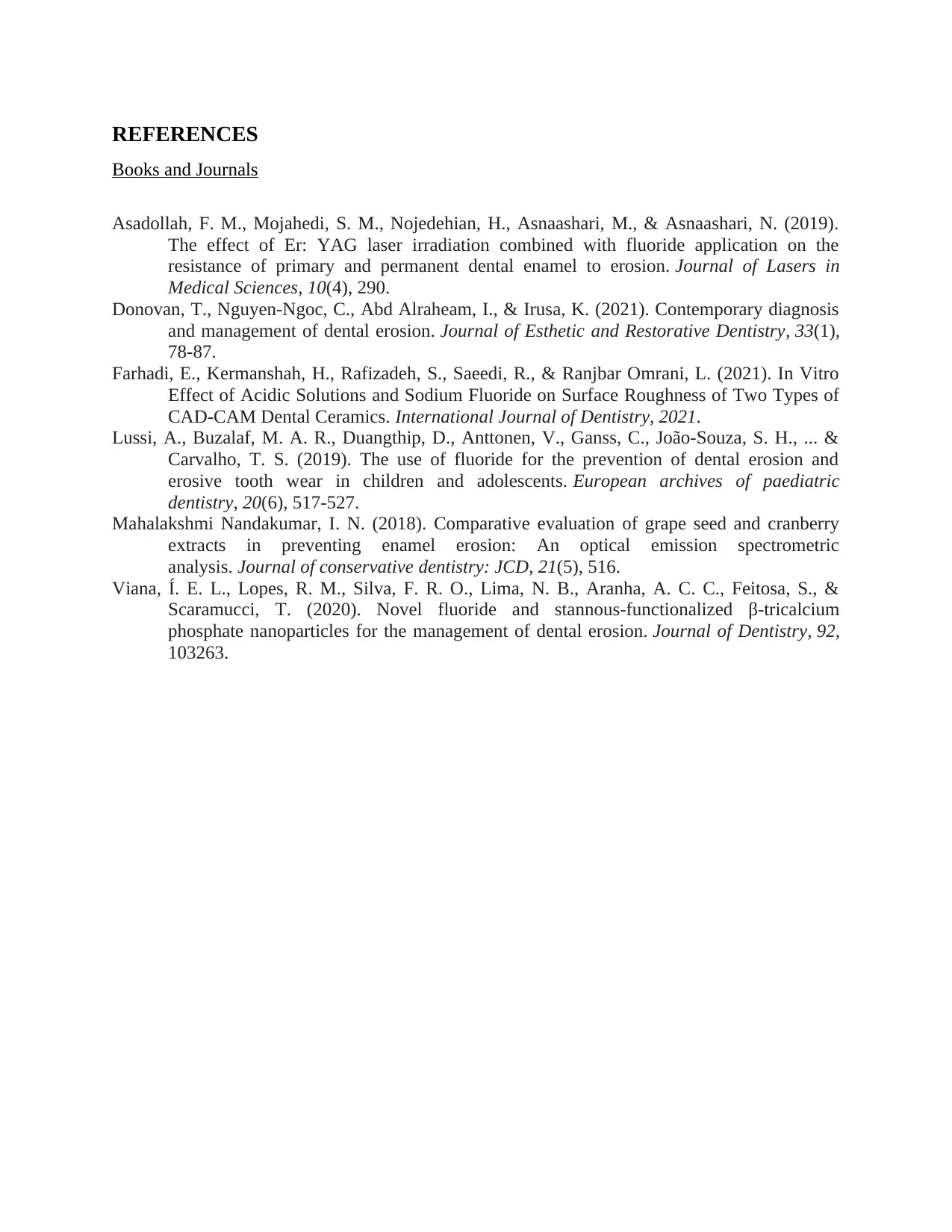
REFERENCES
Books and Journals
Asadollah, F. M., Mojahedi, S. M., Nojedehian, H., Asnaashari, M., & Asnaashari, N. (2019).
The effect of Er: YAG laser irradiation combined with fluoride application on the
resistance of primary and permanent dental enamel to erosion. Journal of Lasers in
Medical Sciences, 10(4), 290.
Donovan, T., Nguyen‐Ngoc, C., Abd Alraheam, I., & Irusa, K. (2021). Contemporary diagnosis
and management of dental erosion. Journal of Esthetic and Restorative Dentistry, 33(1),
78-87.
Farhadi, E., Kermanshah, H., Rafizadeh, S., Saeedi, R., & Ranjbar Omrani, L. (2021). In Vitro
Effect of Acidic Solutions and Sodium Fluoride on Surface Roughness of Two Types of
CAD-CAM Dental Ceramics. International Journal of Dentistry, 2021.
Lussi, A., Buzalaf, M. A. R., Duangthip, D., Anttonen, V., Ganss, C., João-Souza, S. H., ... &
Carvalho, T. S. (2019). The use of fluoride for the prevention of dental erosion and
erosive tooth wear in children and adolescents. European archives of paediatric
dentistry, 20(6), 517-527.
Mahalakshmi Nandakumar, I. N. (2018). Comparative evaluation of grape seed and cranberry
extracts in preventing enamel erosion: An optical emission spectrometric
analysis. Journal of conservative dentistry: JCD, 21(5), 516.
Viana, Í. E. L., Lopes, R. M., Silva, F. R. O., Lima, N. B., Aranha, A. C. C., Feitosa, S., &
Scaramucci, T. (2020). Novel fluoride and stannous-functionalized β-tricalcium
phosphate nanoparticles for the management of dental erosion. Journal of Dentistry, 92,
103263.
Books and Journals
Asadollah, F. M., Mojahedi, S. M., Nojedehian, H., Asnaashari, M., & Asnaashari, N. (2019).
The effect of Er: YAG laser irradiation combined with fluoride application on the
resistance of primary and permanent dental enamel to erosion. Journal of Lasers in
Medical Sciences, 10(4), 290.
Donovan, T., Nguyen‐Ngoc, C., Abd Alraheam, I., & Irusa, K. (2021). Contemporary diagnosis
and management of dental erosion. Journal of Esthetic and Restorative Dentistry, 33(1),
78-87.
Farhadi, E., Kermanshah, H., Rafizadeh, S., Saeedi, R., & Ranjbar Omrani, L. (2021). In Vitro
Effect of Acidic Solutions and Sodium Fluoride on Surface Roughness of Two Types of
CAD-CAM Dental Ceramics. International Journal of Dentistry, 2021.
Lussi, A., Buzalaf, M. A. R., Duangthip, D., Anttonen, V., Ganss, C., João-Souza, S. H., ... &
Carvalho, T. S. (2019). The use of fluoride for the prevention of dental erosion and
erosive tooth wear in children and adolescents. European archives of paediatric
dentistry, 20(6), 517-527.
Mahalakshmi Nandakumar, I. N. (2018). Comparative evaluation of grape seed and cranberry
extracts in preventing enamel erosion: An optical emission spectrometric
analysis. Journal of conservative dentistry: JCD, 21(5), 516.
Viana, Í. E. L., Lopes, R. M., Silva, F. R. O., Lima, N. B., Aranha, A. C. C., Feitosa, S., &
Scaramucci, T. (2020). Novel fluoride and stannous-functionalized β-tricalcium
phosphate nanoparticles for the management of dental erosion. Journal of Dentistry, 92,
103263.
⊘ This is a preview!⊘
Do you want full access?
Subscribe today to unlock all pages.

Trusted by 1+ million students worldwide
1 out of 6
Related Documents
Your All-in-One AI-Powered Toolkit for Academic Success.
+13062052269
info@desklib.com
Available 24*7 on WhatsApp / Email
![[object Object]](/_next/static/media/star-bottom.7253800d.svg)
Unlock your academic potential
Copyright © 2020–2025 A2Z Services. All Rights Reserved. Developed and managed by ZUCOL.





